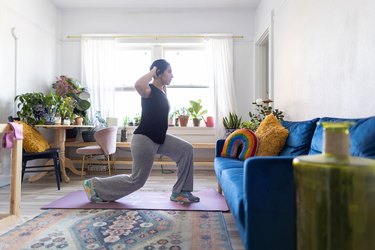
In an ideal world, both sides of your glutes would function together in perfect harmony.
But it's possible that, over time, one side of your butt can become stronger than the other — whether through repetitive daily tasks, an imbalanced workout program or a past injury.
Video of the Day
Why should you care about uneven glutes? For starters, the three muscles that make up your butt — your gluteus maximus, medius and minimus — are responsible for a lot of daily movements, particularly walking and squatting. And though they function independently, they're also used together, which means they both need to be equally up to the task.
"Any muscular asymmetry in the body is predictor of future injury," Holly Perkins, CSCS, creator of The Glutes Project ACTIVATE, tells LIVESTRONG.com, adding that she sees glute imbalance in about 80 percent of her clients. Potential injuries from a glute imbalance or glute weakness include knee, hip and back, she says.
After all, when a muscle group isn't working as it should, other ones down the line pick up the slack. That can leave them vulnerable to injuries, including overuse injuries, since the muscle is under increased load and being called on to do things it doesn't usually have to do.
"In order to protect your body from a variety of injuries, you want to aim for balance in the glutes and hip structure overall," she says. To help you stay balanced, here's a quick, 10-second test to see if one side of your glutes is stronger than the other, as well as three simple exercises to get them back in sync.
How to Tell if You Have Uneven Glutes
Giving your butt cheeks a squeeze probably isn't the best way to measure your strength. Instead, Noam Tamir, CSCS, owner and founder of TS Fitness, recommends you try the split squat test.
- Stand with your feet at hip-width distance.
- Step your right foot back, keeping your heel raised, balancing on the ball of your foot.
- Bend both your knees to 90 degrees with your right knee just hovering above the ground.
- Press into your left foot to straighten your knees and return to standing.
As opposed to a squat-style test, where it's easy to compensate for imbalance on one side or the other, this motion puts all the focus on your front leg, making it easier to spot uneven strength, Tamir says.
If one side feels significantly more challenging than the other, you may have some muscle imbalance.
Tip
If the split squat test feels too challenging, Tamir recommends you try a single-leg glute bridge. This move is generally safer for people with knee issues and difficulty maintaining stability.
All you do is perform a glute bridge with one foot raised off the ground. If one side feels way more difficult than the other, that glute may be a little weaker.
Fix Uneven Glutes With These 3 Exercises
So, you've got a glute imbalance. Now what? For most people, a smart, consistent at-home training strategy is enough to level things out and help ensure healthy hip function. (If you're experiencing any lower back, hip or knee pain, please see a physical therapist for professional evaluation.)
In addition to regularly performing full-body strength moves that strengthen your glutes, cozy up to the following three exercises that Perkins uses with her clients. For the best results, consistency is key. Do them three or more times per week. Start with 2 to 3 sets of 10 reps on each leg (or fewer if you're feeling unstable), then gradually progress to 15.
Move 1: Cook Hip Lift
- Lie on your back with your knees bent and feet flat on the floor, close to your butt.
- Bend one knee into your chest and hold with both arms. This is the starting position.
- Press your heel into the floor to drive up your hips, keeping them squared to the ceiling. You want to end up with your body in a straight line from your knee to your shoulders.
- Lower back down with control and repeat.
- Do the same on the other side.
Tip
This exercise may feel a bit awkward, but it's great for the mind-body connection, Perkins says. Really focus on activating/squeezing the planted leg's glutes at the top of the movement.
Move 2: Hip Hike
- Stand tall with your feet together and core engaged.
- Lift your right foot off of the floor and bend your right knee. Your left (standing-leg) knee will be slightly bent (not locked out).
- Raise your right hip a few inches toward the ceiling while keeping your shoulders level and squared to the front.
- Lower your hip back down so your hips are even again and repeat.
- Do the same on the other side.
Tip
If you tend to lose your balance, touch your toe to the ground in between hip hikes, Perkins says.
Move 3: Single-Leg Reach
- Place a chair, box or other knee-height object an arm's length in front of you.
- Stand with your feet together, then shift your weight to your right leg, bending the knee slightly.
- Push your hips back behind you, letting your left leg float back behind you and reaching for the object in front of you.
- Pause when your back leg is parallel to the floor (or however high you can go without rotating your hips or losing your balance).
- Squeeze your standing leg's glutes to pull your body back to standing.
- Repeat, then do the same on the other leg.
Want Even More Glute Goodness?
Check out The Glutes Project ACTIVATE training program from Perkins for more corrective exercises to fix unbalanced glutes and build your booty.